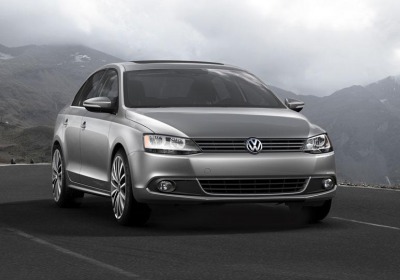2011 Volkswagen Jetta revealed
Tue, 15 Jun 2010
Volkswagen has long marketed German engineering and decidedly European technology--think turbodiesels--in cars. But for 2011, the Jetta sedan goes in a different direction--a more American one.
As the linchpin of VW's ambitious plans for growth in the U.S. market, the Jetta has been redesigned to accommodate the more-space mantra of Americans. A larger, more upscale version of the Volkswagen Jetta was revealed on Tuesday ahead of its arrival in the States in October.
Volkswagen says emphasis was also placed on content and technology--two more hallmarks U.S. consumers demand in modern daily drivers. A nicely loaded model will start at about $16,000, though base versions will be less expensive.
And in a further nod to American consumer tastes, VW is going green--as in a hybrid. A hybrid model will join the Jetta stable in 2012, marketing and product vice president Toscan Bennett told AutoWeek.
Volkswagen did considerable work on this new model. The platform, or module in VW parlance, is new, and the sheetmetal is also redone. Under the hood, the changes continue, most notably with the addition of the GTI's 2.0-liter, 200-hp four-cylinder engine. A new base engine, making 115 hp, is joined by the carryover 2.5-liter five-cylinder unit making 170 hp. Also returning is the turbodiesel engine, which will have an output of 140 hp and 236 lb-ft of torque.
EPA numbers are not in, but VW say the fuel-economy ratings will be at least as good as last year's. The TDI turned in particularly impressive figures--to the tune of up to 42 mpg on the highway. A six-speed manual is standard, and the six-speed DSG automatic is optional.
The Jetta gets sleeker sheetmetal for the new model year, and it's fronted by trapezoidal headlights and a high-gloss black grille. The sides are marked by prominent wheel arches, which hold tires as large as 18 inches. Two-section taillights set off the back end of the car. Look closely at the shoulders, and the NCC concept is visible, while the mirrors borrow their appearance from the premium CC sedan, VW says. The car will come in S, SE, SEL and TDI (diesel) models in the United States.
The updated Jetta measures 182.7 inches in length, a growth spurt of 3.5 inches over its predecessor. This helps improve interior comfort, and legroom is now 38.1 inches, 2.6 inches more than before. The cabin also features a new steering wheel. In back is a 40/60 split rear seat. The car also will have standard keyless entry, a sophisticated infotainment/nav option and VW's maintenance coverage packages.
Despite the growth, the Jetta's curb weight is actually lighter for the base model for 2011, and the car will continue to compete against such compact stalwarts as the Honda Civic and the Toyota Corolla.
Volkswagen
Volkswagen has increased the size of the 2011 Jetta, added a new 200-hp engine from the GTI, and wrapped it all in new sheetmetal.
More Variations to Come
As hinted to by the well-received NCC concept at the Detroit auto show in January, the new Jetta is also among the models earmarked to receive Volkswagen's new gasoline-hybrid system. It mates a 150-hp supercharged and turbocharged 1.4-liter four-cylinder gasoline engine with a 27-kilowatt electric motor and lithium-ion battery for a claimed 45 mpg.
Also under consideration is a new performance flagship powered by a 265-hp version of the turbocharged 2.0-liter four-cylinder direct-injection engine. This new front-wheel-drive model is planned to form part of Volkswagen's R lineup--albeit as a U.S.-only model, according to AutoWeek sources.
As with the outgoing model, the sixth-generation Jetta will be produced at Volkswagen's Peubla plant in Mexico alongside the New Beetle, which is set to be replaced by an all-new, second-generation model in 2011.
Volkswagen will always be about German engineering and a distinctive driving style. But to sell more cars in the United States, the company has decided to go larger. As Bennett put it, “Americans like and need bigger cars.”
Greg Kable contributed to this report.
By Greg Migliore

